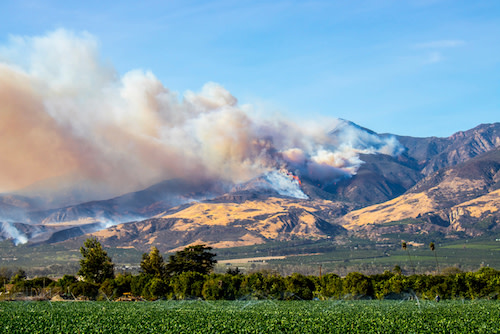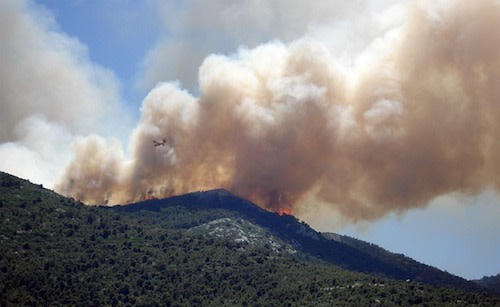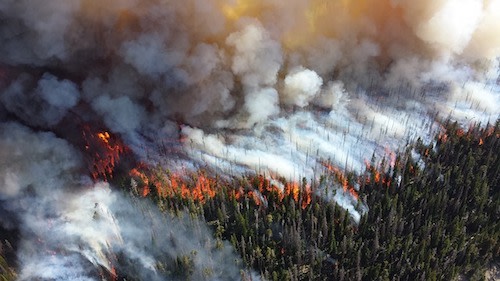Wildfire Smoke: How to Avoid Serious Respiratory Problems
While the news is often packed with dramatic images of burning neighborhoods, it's the lingering smoke that creates the biggest threat for most people. Residents in fire-prone areas are more likely to have lung and respiratory issues cause by smoke than to watch their homes burn.
So how can you protect your yourself?
You can start by being informed on wildfires, prepare for an emergency, and maintain quality air in your home.

Causes of Wildfires
While wildfires have always been a part of nature, there is evidence that suggests they have become more common over the past 30 years. According to Wildfire Today, which cites information with the National Interagency Fire Center, the total number of acres in the U.S. that have been exposed to wildfire has risen from under 2.5 million in 1990 to 9.7 million acres in 2017. This is a massive climb in the total amount of fire-damaged area, despite the fact that the number of individual wildfires has actually declined.Essentially what we have is fewer instances, but each instance is bringing extremely high amounts of damage. Wildfire Today says that in 1990 the average size was roughly 22 acres. They believe the average size of a wildfire in 2017 was 139 acres, a massive leap in size and scope.
What is causing all this damage?
After all, with increased expansion of housing needs, leading to more deforestation, you could reasonably assume that fires would be smaller. However, the U.S. Forest Service has studied the issue and identified a few important contributors to wildfires, which they say are one of four major threats to U.S. forests.
They claim there is simply too much overgrowth and unhealthy plant life in today's forests, and trees are generally packed in tighter than they were centuries before. According to their research, an acre of pine forest historically held only a few dozen trees; today you can count hundreds or even thousands of trees in an acre of forest. Instead of a few large trees, we now generally see thickets of smaller trees, which are more vulnerable to drought, insect damage, and disease. When killed by these problems, the tree dries and becomes fuel for large forest fires.

The Respiratory Risks of Wildfire Smoke
With so many wildfires burning each year, what does it mean for the population in general?How will these issues affect our health, especially our respiratory health?
As we'll see, the increase in wildfires doesn't just create the dramatic destruction of homes, it also causes significant health concerns that can linger long after the flames are extinguished.
Smoke is more than just a hazy gray gas. It's a complex mixture of gases and fine particles that are produced when wood, leaves, and other combustible materials are burned.
The largest health threat, however, is from the fine particles. This microscopic particulate matter is small enough to penetrate deep into your lungs, causing a wide variety of health effects that include coughing and wheezing. These particles can also cause burning eyes, runny nose, and a variety of chronic heart and lung conditions.
Certain people are at a higher risk of the negative effects from smoke pollution.
Anyone who has a pre-existing heart or lung disease, such as COPD or asthma with shortness of breath, should be especially wary of smoke. Older people in general are also more prone to health conditions caused by smoke than younger adults.
However, children are also more vulnerable to the problem. Because their lungs and respiratory systems are still growing, children can have significant problems when exposed to wildfire smoke. Pregnant women should avoid smoke, as it can be a threat to both the woman and the baby.
People with diabetes can also have higher risks when exposed to smoke, as it cause issues with underlying cardiovascular diseases.
Carbon monoxide, which is found in wildfire smoke, can reach your lungs, further can enter your bloodstream, reducing the body's ability to deliver oxygen to organs and limbs. While the noticeable effects are generally only seen in vulnerable populations, it is possible for almost anyone to experience headaches, dizziness, and visual impairment caused by prolonged carbon monoxide exposure.
There is a concern among the general public that wildfire smoke could be causing cancer. While the research behind this specific theory is still sparse, there is evidence that people who are exposed to long-term smoke inhalation in general may have slightly higher risks for cancer or other chronic health issues.
Protecting Yourself Against Wildfire Air Pollution
This all brings us to the most important part of our entire discussion: protecting yourself against wildfire smoke. The best strategy against wildfire smoke is avoiding exposure as much as possible. Whether or not you have existing respiratory diseases or increased risk, avoiding areas where smoke is thick will keep you from breathing in the contaminants.Stay Prepared for Smoke Emergencies
If you have a condition that impacts your lungs and you live in a fire-prone area, talk with your doctor to create a plan of action should smoke impact your neighborhood. You should be completely clear on when you need to leave if smoke is present, and how much medicine you should have on hand in case of an emergency.Keep a full supply of air masks on hand to protect yourself and your family. You can find them at many local hardware stores. These air masks should have an N-95 or P-100 rating; be sure that you have the right kind, as regular dust masks, which are used for construction and industrial purposes, only trap large particles like sawdust.
You can stay up-to-date on local air quality through sites and news reports. One of the most valuable resources is the AirNow map from the EPA. This interactive map gives you current readings of air quality, allowing you to make informed decisions on air-pollution protection.
How to Deal with Wildfire Smoke
If nearby forest fires are causing significant air pollution levels in your area, local authorities may advise that you stay indoors. If this happens, be sure to close all windows and doors to keep smoke outside.If you have an air conditioner keep it running and make sure there is a clean air filter inside the unit. While these air filters are not meant to trap smoke particles (they are meant to keep the A/C unit clean), a clean filter can help reduce airborne particles of all sizes in the home.
When outside air quality improves, open windows and doors and let the natural breeze clean away any smoke particles that may have entered the home.
In some cases, fires can continue to burn for a long time, causing a significant buildup of smoke in your home, even if you are taking all the right precautions. If smoke remains strong for a long time, you could have dangerous amounts in your home, so be sure that you are not adding to the problem by using things that burn. Avoid wood-burning fireplaces, gas logs, and gas stoves for cooking. Even candles can contribute to the issue, so do your best to avoid these items.

Oransi Air Purifiers for Wildfire Smoke Removal
It's also possible to increase the air quality in your home by using an indoor air cleaner. Air purifiers that use advanced technology such as HEPA filters and activated carbon trap some of the smallest particles in the air, removing many of the contaminants that make smoke pollution dangerous.EJ Air Purifier
This effective air purifier uses a medical-grade HEPA filter and a proprietary carbon that delivers superior gas filtration. Not only does the EJ120 air purifier remove contaminants from the air, it also uses a German-engineered motor that maintains quiet performance; it's virtually silent when set on the two lowest speeds! Despite it's relatively-small size and quiet performance, it can effectively clean a room measuring only 1,500 square feet.Erik 650A Air Purifier
If you want something even more powerful for your smoke-removal efforts, consider purchasing the 650A air purifier. This advanced piece of technology uses a MERV18 HEPA filter that removes 99.99% of all particles in the air, which is above and beyond the HEPA minimum standards. If also uses a proprietary filter that removes a wide range of gas, odors, and particulate matter. It's so powerful and effective that it can actually be used in healthcare facilities or for mold-remediation efforts.If you want more information on our advanced air purifiers for smoke removal, contact the team at Oransi anytime and we'll make sure you have the right information to make an informed decision and help your breathing problems.
Whether you need a small purifier for a child's bedroom or a large air cleaner for a commercial office, we have the products and filters for a life of clean air!
